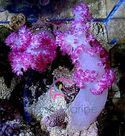Orange Carnation Coral - Dendronephthya species - Carnation Soft Coral - Christmas Tree Coral - Strawberry Coral - Tree Coral
Not Cover Under Arrive Guaranteed

Orange Carnation Coral belonging to the kingdom Animalia, Phylum Cnidaria, Group Coral, Class Anthozoa, Order Alcyonacea, Family Nephtheidae and Genus Dendronephthya, Orange Carnation Coral is one of the most beautiful corals found globally. Although look wise the most eligible buy for the marine aquariums, Orange Carnation Coral is difficult to keep. Despite the difficulties, you cannot resist the temptation and the challenges of acquiring and maintaining it. This article briefs you about Orange Carnation Coral. This information should be helpful for you in maintaining your marine aquarium with this beautiful coral.
Other names: Orange Carnation Coral is also commonly known as Orange Soft Coral, Orange Tree Coral and Orange Cauliflower Coral while, its scientific name being Dendronephthya species.
Coral type: Soft Coral.
Origin or natural range:Orange Carnation Coral originates from tropical Pacific and Indian Oceans.
Food: Orange Carnation Coral is carnivorous in nature. It filter feeds marine miniscule and acellular planktons. It feeds a few numbers of times per week.
Size: As compared to the other marine invertebrates, an Orange Carnation Coral is average in size. However, the Coral may vary tremendously in size. It may look very small, as small as 2 inches to 3 inches, when tightly closed but, may expand many times when open. When you buy an Orange Carnation Coral, it may be closed. It will open up in a few weeks time once it adjusts in your marine aquarium.
Color: Orange Carnation Coral exists in only orange color.
Morphology: Orange carnation Coral has many tentacles and each tentacle has eight polyps. Being a soft coral, its body tissue has calcareous spicules to retain its body structure. Orange Carnation Coral may have a variation of orange color in the various areas of its body.
Compatibility: As compared to the other marine invertebrates, Orange Carnation Coral is relatively non-aggressive.
Habit: Orange Carnation Coral is non-photosynthetic to very slightly photosynthetic and therefore, lives in darker regions of the marine water. The coral filter feeds to get the required
nutrients and therefore, needs to live in an area with average to high water movement.
Habitat: Orange Carnation Coral is found in the Indo-Pacific region to the Red Sea. The coral attaches itself in caves, in the ill-lit areas of reefs or on the ledges of the reef.
Breeding: Orange Carnation Coral hardly breeds in an aquarium. If you, however, facilitate the coralís division for propagation in your aquarium, the affected area of the coral should be softly attached to a hard surface exposed to water current for a speedy recovery.
Growth environment in your marine aquarium:
- Temperature: 72 to 78 degrees Fahrenheit or 23 to 26 degrees Celsius.
- Specific gravity: 1.023 to 1.025. pH: 8.30 to 8.40.
- Illumination: Low to moderate illumination is fine for the Orange Carnation Coral. As the coral is slightly photosynthetic to non-photosynthetic, it does not require intense light.
- Water flow in the aquarium: Orange Carnation Coral requires moderate water flow in the marine aquarium. Alternating water flow is the best. Water flow directed towards the walls of the marine aquarium is also good.
- Marine aquarium habit & habitat: Orange Carnation Coral looks interesting if you attach it inverted on a reef ledge or in a cave in your marine aquarium. Feeding: To feed the coral, softly nudge the substrate, the surface on which Orange Carnation Coral is attached. This nudging will move the coralís food from its place and the coral can feed easily. Alternatively, a water flow full of phytoplankton and other invertebrates is an ideal way to feed an Orange Carnation Coral. For more nutrition of the coral, tested trace elements should be regularly added to your marine aquarium water.

Red Carnation Coral - Dendronephthya species - Carnation Soft Coral - Christmas Tree Coral - Strawberry Coral - Tree Coral
Freshmarine: $139.98
You Save 22.23%
Colt Coral - Cladiella species - Blushing Coral - Soft Finger Leather - Colt Soft Coral
Freshmarine: $83.98
You Save 30.01%
Medusa Soft Coral - Sphaerella species - Christmas Tree Soft Coral - Medusa Tree Coral - Potato Coral - Xmas Coral
Freshmarine: $99.98
You Save 23.09%
Young Soft Coral - Cladiella species - Young Finger Leather Coral - Blushing Coral - Cauliflower Coral
Freshmarine: $44.98
You Save 18.19%
Before Placing Your Order
Store InformationShipping Info
Payment Info
Return Policy
Arrive Alive Guarantee
Adoptation Policy
After Placing Your Order
Track Your OrderSecurity Safe Shopping
Compatibility Chart
Shoppers Review









